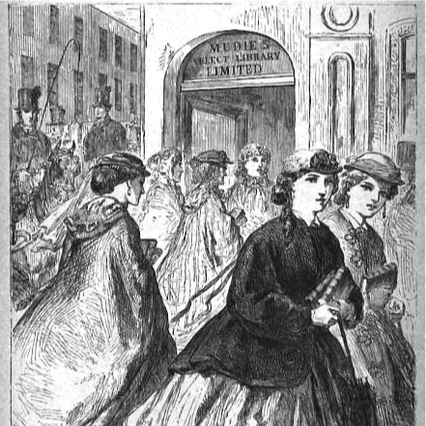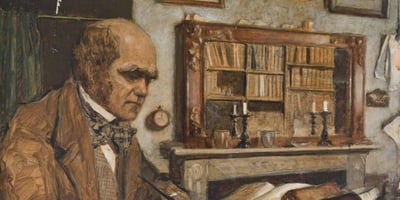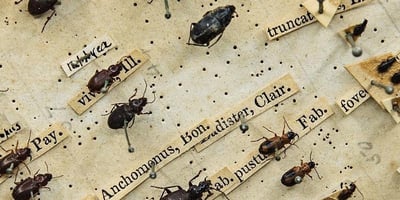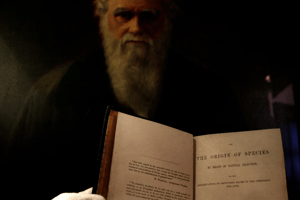The Story of Charles Darwin: Chapter III Read Chapter II here. Hunched over a desk, brows furrowed,...
‘On the Origin of Species’, 163 Years Later
The Story of Charles Darwin: Chapter V
Read Chapter IV here.
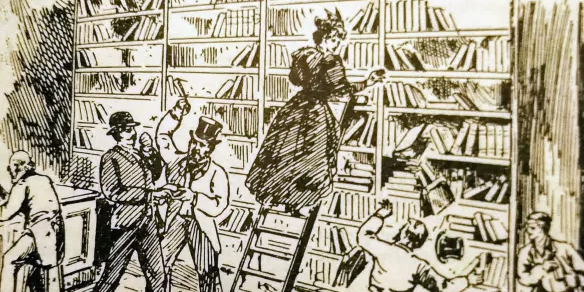
Sounds of hushed whispers, the pitter patter of feet on thick linen carpeting, and the delicate flutter of pages as novels were consumed in earnest, filled the hall. She walked through the narrow archway, and gasped softly. It was far better than anything she had imagined.
Endless rows of mahogany shelves towered over her, lining circular walls, stretching into the distance for as far as the eye could see. Sunlight poured in through glass panels fitted in the canopy ceiling, casting light on every inch of the space, so she could even see the little catacombs that snaked off from the main room, replete with more books. There were hardbound copies and paperbacks, and a smaller, more colourful section with vivid illustrations.
Little gold plaques labelled the shelves, but she ignored these and strode purposefully towards the far end of the library, mouth slightly agape as she took in the sights. If the information she had been given was right, she would find the copy in the aisle second to last, by the maps and travel almanacs. A little stepladder was waiting for her at the end of the aisle. Mounting it, she began her search by scanning the topmost shelves.
Her fingers grazed the stack of books that occupied the shelf below, and came to rest on one volume, snugly tucked at the very end. Her heart skipped a beat. Slowly, she ran her index finger down its beautiful green spine, and picked it off the shelf, admiring the intricacy of its gilt embroidery. As she flipped the front cover, the thumping in her chest grew louder. Elation set in as she recognized the book was a beautifully preserved first-edition. At long last, her wait was over.
That night, all lights in the little village of Lavenham, Suffolk went out by 11 pm, save one.
The young lady sat at a desk, making notes with the book propped up on a stand beside her for reference. The resemblance she bore to its author as he worked on it many years ago was almost eerie. A few weeks before her, that particular copy had been unintentionally chanced upon, and transferred to a cubbyhole in the wall of a Parisian book collector’s home, as he was quite taken with its binding. A few months before then, sections of the book were being read aloud at a dinner party. A little before then, it had inspired a young man, much like a young Darwin, to pursue the study of botany. Somewhere else in the world, similar first-edition copies were making the rounds of universities, theatres and gentlemen’s clubs.
Charles Darwin’s collection of knowledge, ideas, and stories had travelled the world in the form of the ‘On the Origin of Species’, and seen almost as much as he had.
A pit-stop for literary travellers of all kinds
In the Victorian era, reading offered all classes of individuals a form of temporary escapism, and education on various topics. Books acted not only as a medium to create fantastical fiction, but also as a commentary on social and political trends at the time.
Charles Edward Mudie, a prominent British publisher at the time, wanted to make reading a universal interest. In 1842, he founded a lending library, which cost people only 1 guinea a year to sample copies from his vast selection of books, including science compositions, almanacs, biographies, adventure books, and novels. This encouraged students, and soon, other readers to begin borrowing books from his collection.
He also gradually refined his collection, leaving out books considered distasteful or those he believed tarnished Victorian norms and culture. Eventually, 500 copies of Charles Darwin’s revolutionary ‘Origin of Species’, widely celebrated Austen novels and other classics such as Ivanhoe, found their way onto his shelves. Interestingly, Mudie also added Emma Darwin’s ‘Century of Family Letters’ to his collection, after the success of her father’s publication. The exclusivity of this collection drew in larger crowds, leading to its increased success as a centre for bibliophiles, offering passionate reading, and learning.
At a time when the only way to acquire books was to wait for months to buy them, at exorbitant costs no less, this solution, offering the circulation of knowledge and literature was truly remarkable, making Mudie’s lending library one for the books.
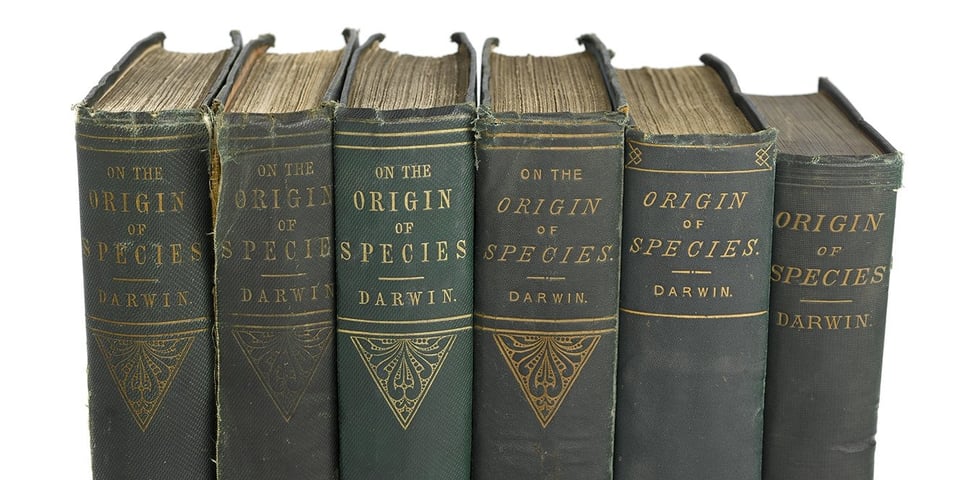
The journey of Darwin’s copy
Darwin’s ‘Origin of Species’ was created with the intent of making these ideas a mass publication, granting equal access to everyone. It seems only right then that after the initial publication of first-edition copies in 1859, they went on to become a part of Mudie’s historic collection- a collection of over 7.5 million books that acted as a proponent of knowledge, and accrued wisdom for decades. The circulation of ‘The Origin of Species’, one of its prime occupants, helped enlighten the masses on the genesis of life, and propagated revolutionary developments in all fields of science.
Darwin’s other notes, letters and collections also continue to educate people today, occupying spots in renowned museums across the world like the Smithsonian, the Natural History Museum, and Darwin’s own alma mater, the University of Cambridge.
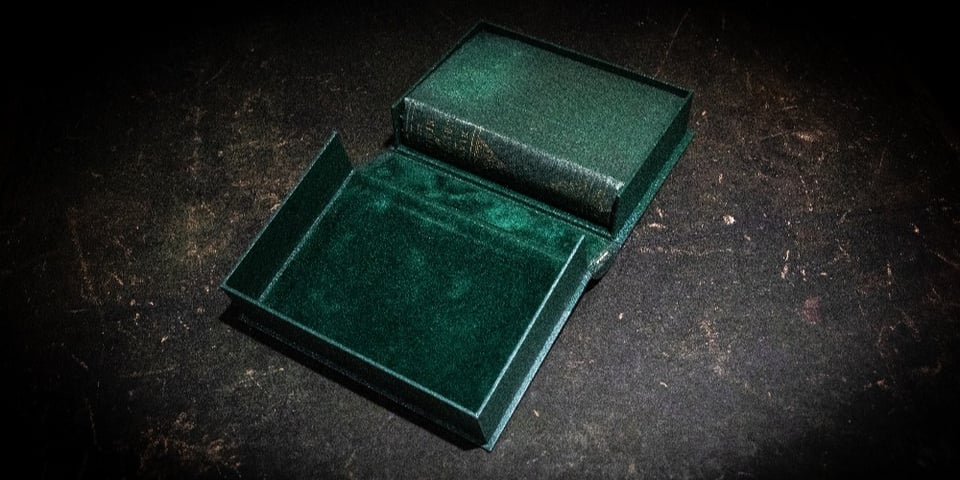 Survival of the finest
Survival of the finest
Introducing our latest Showpiece- one of only 1250 copies printed of Charles Darwin’s first edition ‘On the Origin of Species’, with its original mid-Victorian era binding intact, and in pristine condition. Having once resided in Mudie’s Library, this copy has passed through many hands, and struck many minds, but managed to retain its condition. Oliver Bayliss, founder of Bayliss Rare Books, dealers of iconic first-editions from around the world, said of the manuscript, ‘It is rare to find a copy in such condition. This is up there with the best I’ve seen, an absolutely stunning example’.
This first-edition specifically boasts a number of special features missing in later editions. For instance, the book carries a half title on the cover page, an ‘Edmond and Remnant’s binder’s ticket, and 32 pages of advertisement that name ‘Murrays’ the original publishers of the book.
The excitement was palpable. Despite it being a typical day at the office, almost little to no work seemed to be getting done. Every now and then, a different pair of eyes would flit to the dials on the clock hung in the room, waiting for time to tick down. Every buzz of the front door elicited a twitch, or a jump, and several pairs of legs were fidgeting and shaking rhythmically under the shared desk, in anticipation of the new arrival.
Then, just as everyone had resigned to reverting their attention to work, there was a buzz, accompanied by a knock on the door. Instantly, everyone was on their feet- all six seats were empty. Contained in a sturdy green quarter solander box, the manuscript was a deep emerald green hardcover, revealing perfectly unblemished stock paper; a beautifully bound exemplification of an incredible feat of science.
A single glance at the volume was enough to confirm the extent of its significance. It was possible to understand the sentiments that arose in the room that day, without anyone that was present uttering so much as a single word. We were bearing witness to living, breathing history.
At Showpiece, we like to think we’re helping ‘On the Origin of Species’ make the impact Darwin had always dreamed it would, by offering you a chance to own it.
Read Chapter VI here.
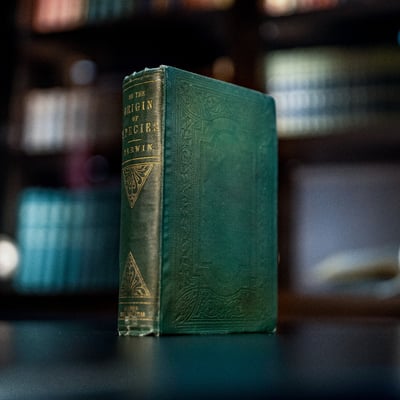
Showpiece has made it possible to own the book that changed the world. Find out more about our £275,000 first edition ‘On the Origin of Species’, and its incredible journey over 163 years. Available now from £50, find out more.
Read more about where Darwin's treatise lived before it reached Showpiece:
https://www.ucl.ac.uk/bloomsbury-project/institutions/mudie.htm
http://britishcirculatinglibraries.weebly.com/mudies-select-library.html

